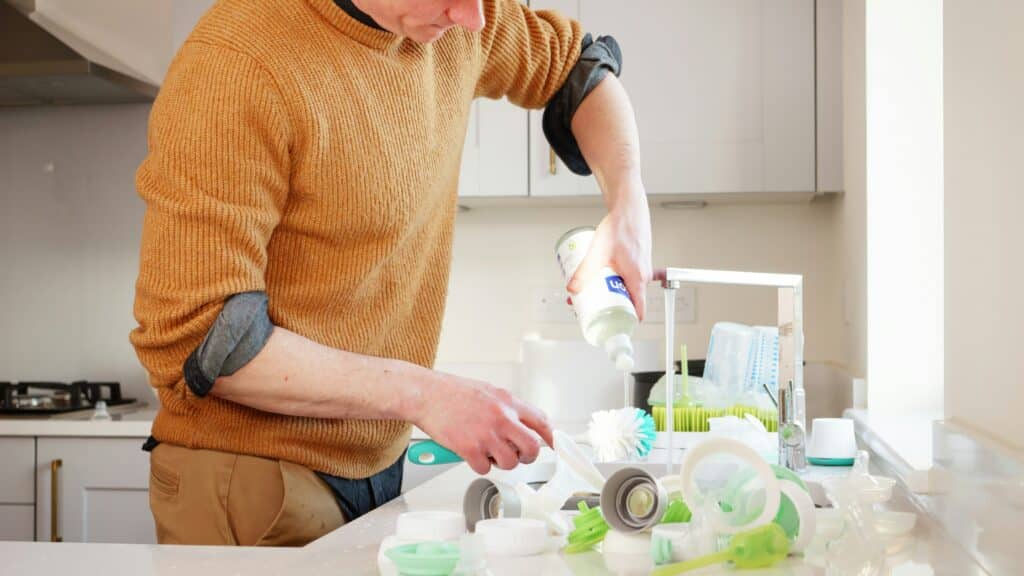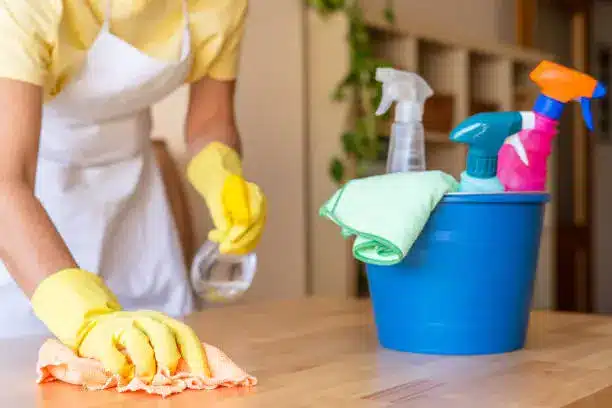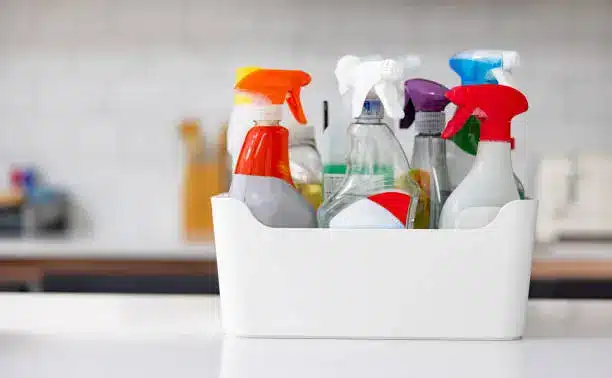You’re not alone. Choosing the right cleaning product for every surface in your home can seem like an insurmountable task. Not to mention, the harsh chemicals in many commercial cleaners can be harmful to your health and the environment. But what if I told you that you could create effective, eco-friendly cleaning solutions right in your own kitchen?

Yes, you read that right. The DIY (Do-It-Yourself) movement has been growing by leaps and bounds, especially in the home cleaning sphere. This is due, in no small part, to the increasing awareness about the negative impacts of chemical-based cleaners and the desire to adopt a more sustainable and safe approach towards housekeeping.
Today, I’m excited to share with you some of my favorite, tried-and-true recipes for DIY scrubs and sprays that can clean virtually every surface in your home. From your kitchen countertops to your bathroom tiles, these homemade cleaners will leave your home sparkling, without leaving behind any toxic residues. 😊
But why go the DIY route, you might ask? Apart from being kinder to your wallet and the planet, making your own cleaning products gives you the power to customize. Love the refreshing smell of citrus? Add some lemon essential oil to your all-purpose cleaner. Want a gentle scrub for your delicate wooden surfaces? Opt for a milder abrasive like baking soda in your scrub recipe. The possibilities are endless and thoroughly within your control.
By the end of this comprehensive guide, you’ll be well-versed with the basics of DIY cleaning products, including the ingredients you’ll need, the step-by-step process to make each cleaner, and the best ways to use them for optimum results. Plus, I’ll share some pro-tips to ensure your homemade cleaning venture is a resounding success.
What You Can Expect In This Article
We’ll begin by exploring some of the key ingredients you’ll need to make your DIY cleaning solutions. From common kitchen staples like vinegar and baking soda, to essential oils for that pleasing fragrance, we’ll cover the what, why, and how of each ingredient.
Next, I’ll walk you through the process of making a range of DIY cleaners – all-purpose sprays, kitchen scrubs, bathroom cleaners, window sprays, and more. Each recipe will come with detailed instructions, so even if you’re new to the DIY scene, you’ll have no trouble following along. 👍
We’ll also delve into the science behind these DIY cleaners. Why does vinegar work as a disinfectant? How does baking soda help remove stains? Understanding the mechanics of these homemade cleaners will not only satisfy your inner geek, but also boost your confidence in their efficacy.
Finally, we’ll talk about storage and safety guidelines for your DIY cleaners. Just because they’re made from natural ingredients doesn’t mean they don’t warrant caution. Proper storage and handling ensure your cleaners stay effective and safe for use.
So, whether you’re a cleaning enthusiast or someone just wanting to cut down on chemicals in your home, this guide will provide you with practical, sustainable solutions. Let’s roll up our sleeves and get started! 🌿
Sparkling Fresh: Understanding DIY Cleaning Solutions
Before you dive headfirst into the world of do-it-yourself (DIY) cleaning solutions, it’s vital to understand the science behind them. Many people are turning to homemade cleaning solutions, not just because they are economical, but also because they are eco-friendly and less harmful to our health. 🌱 But what makes these DIY solutions effective? Let’s explore.
The power of DIY cleaning solutions can be attributed to a few key ingredients commonly found in your kitchen or pantry. These include vinegar, baking soda, lemon, and even salt. Vinegar, for example, is an excellent disinfectant and deodorizer due to its high acid content. Similarly, baking soda has mild abrasive properties that can help scrub away stubborn dirt and grime.
Furthermore, these DIY solutions often include essential oils not only for their pleasant aroma but also for their various cleaning properties. Tea tree oil, for instance, is renowned for its antifungal and antibacterial capabilities. If you’re intrigued and want to start creating your own DIY cleaning solutions, stay tuned. Below is a detailed guide on how to formulate scrubs and sprays that will leave every surface in your home gleaming. 💫
The DIY Essential: Homemade All-Purpose Cleaner
First things first, let’s discuss how to concoct your own all-purpose cleaner. This DIY cleaner is perfect for cleaning countertops, kitchen surfaces, and even bathroom tiles. Plus, it’s super easy to make!
You will need 1 part white vinegar, 1 part water, and lemon rind. Simply combine the ingredients in a spray bottle, give it a shake, and voila! You have your own homemade all-purpose cleaner. But what makes this blend so effective?
The white vinegar in the solution acts as a potent disinfectant and deodorizer, capable of killing most germs and bacteria. The water dilutes the vinegar, reducing its strong scent and making it safe for various surfaces. Meanwhile, the lemon rind adds a fresh scent and provides additional cleaning power due to its citric acid content. For an insightful demonstration of this DIY cleaner, check out this informative video: “DIY All-Purpose Cleaner” by the YouTube channel Clean My Space.
Scrub-a-Dub: DIY Scrubs for Tough Grime
For stubborn stains and grime, a DIY scrub can come in handy. One such scrub can be made from baking soda and water. You simply need to create a paste by mixing equal parts of the two ingredients. This scrub is particularly effective for bathroom tiles, sinks, and oven tops.
The baking soda, also known as sodium bicarbonate, reacts with water to form a mildly abrasive paste. This paste can help dislodge stubborn dirt and grime without scratching your surfaces. However, for a more potent scrub, you might want to add a bit of dish soap to the mix. The soap will cut through grease, making the scrub even more efficient.
Another fantastic scrub you can whip up involves just salt and lemon. The coarse texture of the salt combined with the citric acid in the lemon creates a powerful cleaning agent perfect for cutting boards and copper items. For a visual guide on making these scrubs, watch “DIY Cleaning Scrubs” by the YouTube channel DIY Natural.
Shimmer and Shine: Homemade Glass and Mirror Spray
Looking for a streak-free shine on your windows, mirrors, and glass surfaces? A DIY glass and mirror spray is your answer. This easy-to-make solution only requires three ingredients: distilled water, white vinegar, and cornstarch.
Here’s how to do it: Combine 1 cup of distilled water, 1 tablespoon of vinegar, and 1 tablespoon of cornstarch. Shake well to ensure the cornstarch is fully dissolved, and your DIY glass cleaner is ready to use.
So, why does this concoction work? The vinegar, as we’ve learned, is a great cleaner. But the real star here is the cornstarch. It helps in reducing streaks on your glass surfaces, leaving them sparkling clean. For a practical demonstration, check out the video “DIY Glass and Mirror Cleaner” by the YouTube channel Clean My Space.
Table Comparison of DIY Cleaning Solutions
Now that we have a good understanding of various DIY cleaning solutions, let’s review them side by side in a table:
| DIY Cleaning Solution | Ingredients | Uses |
|---|---|---|
| All-Purpose Cleaner | White Vinegar, Water, Lemon Rind | Countertops, Kitchen Surfaces, Bathroom Tiles |
| DIY Scrub (Baking Soda) | Baking Soda, Water, Dish Soap (optional) | Bathroom Tiles, Sinks, Oven Tops |
| DIY Scrub (Salt & Lemon) | Salt, Lemon | Cutting Boards, Copper Items |
| Glass and Mirror Spray | Distilled Water, White Vinegar, Cornstarch | Glass Surfaces, Mirrors |
These DIY cleaning solutions are just the beginning. With a little creativity, you can customize these solutions to suit your preferences and cleaning needs. 🏡💕 Remember, the key to effective cleaning is regularity, so make sure you keep up with your cleaning schedule. Happy cleaning!
Conclusion
To conclude, we have journeyed through a compendious exploration of technicalities in the realm of Information Technology and Engineering. Our discussion has spanned from the basic principles and concepts to the complex and intricate aspects of these sectors. We hope that the article has been successful in elucidating these complex ideas in a comprehensible manner.
Starting from the evolution and significance of IT and Engineering, we have elaborated on how these fields have transformed over the years, and how they continue to revolutionize the world around us. We have also discussed the fundamental principles of software development and systems engineering, which are vital components of these sectors.
Next, we dove into the various layers of a typical IT infrastructure and explored the role of Engineering in creating robust and resilient systems. We have also touched upon the critical role of data management and cybersecurity in the digital age.
In the latter part of the article, we elaborated on the emerging trends and technologies in IT and Engineering, such as AI, machine learning, and big data. These technologies are not just buzzwords, but have the potential to redefine how businesses operate, how products are designed, and how services are delivered.
We also emphasized the importance of continuous learning and staying updated in these fast-paced fields. Whether it’s learning a new programming language, understanding a new engineering concept, or staying updated with the latest cybersecurity threats, it’s crucial for professionals in these fields to keep their skills sharp.
In a nutshell, IT and Engineering are more than just professions; they are the pillars of the modern digital world. With their deep technical knowledge and practical skills, IT and Engineering professionals are driving the innovations that are transforming our lives in countless ways.
As we wrap up, we encourage you to share your thoughts and insights on this article. How has it helped you in understanding the complexities of IT and Engineering? What more would you like to learn? Feel free to comment below.
Sharing is caring, so feel free to share this article with your colleagues and friends who might find it useful. 😊 And if you’re ready to apply what you’ve learned, go ahead and take the plunge! Remember, learning is a continuous process and every step you take gets you closer to your goal.
To delve deeper into these subjects, you can explore these resources:
1. The Practice of System and Network Administration
2. Software Engineering Courses on Coursera
3. Cybersecurity Best Practices
This was your guide, Rodrigo Almeida, signing off. Until next time, keep exploring, keep learning! 💼🚀
Tags: #IT #Engineering #SoftwareDevelopment #CyberSecurity #DataManagement #AI #MachineLearning #BigData
References:
1. Thomas A. Limoncelli, Christina J. Hogan, Strata R. Chalup, “The Practice of System and Network Administration: Volume 1: DevOps and other Best Practices for Enterprise IT”, Addison-Wesley Professional, 2016.
2. Ian Sommerville, “Software Engineering”, Pearson, 2015.
3. CSO, “What is cybersecurity? Definition, best practices & security solutions”, CSO Online, 2019.



